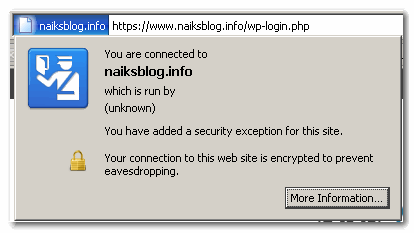Can you check out the HTML source for the below page?
http://www.naiksblog.info/iframeembed.html
More fun at
Can you check out the HTML source for the below page?
http://www.naiksblog.info/iframeembed.html
More fun at
Simple 5 step guide to setting up https with your own self-signed certificate
Prerequisites: Apache2, Ubuntu Server
/usr/bin/openssl genrsa -des3 -out {your domain name}.key 3072
/usr/bin/openssl req -new -key {your domain name}.key -x509 -out {your domain name}.crt
<VirtualHost {your ip}:443>
...
SSLEngine on
SSLCertificateFile {path where certificate is}/{your domain name}.crt
SSLCertificateKeyFile {path where key file is}/{your domain name}.key
SetEnvIf User-Agent ".*MSIE.*" nokeepalive ssl-unclean-shutdown
...
</VirtualHost>
/usr/bin/openssl rsa -in {path where key file is}/{your domain name}.key -out {path where key file is}/{your domain name}.key.nopass# SSLCertificateKeyFile {path where key fileis}/{your domain name}.key
SSLCertificateKeyFile {path where key file is}/{your domain name}.key.nopassIf you receive a certificate warning, simply accept it, and proceed. Congratulations, your communication is now encrypted, and safe from prying eyes!

The following kinds of downloads are available:
Vim scans the first and last few lines of the file for modelines, if the modeline option is on (which it is, by default). If it finds any it will apply those settings as if you had typed them in manually using :set in command mode.
#!/bin/sh
# vim:ts=2:sw=2:expandtab
Übergibson: Embedding vim Settings in the File You’re Editing.